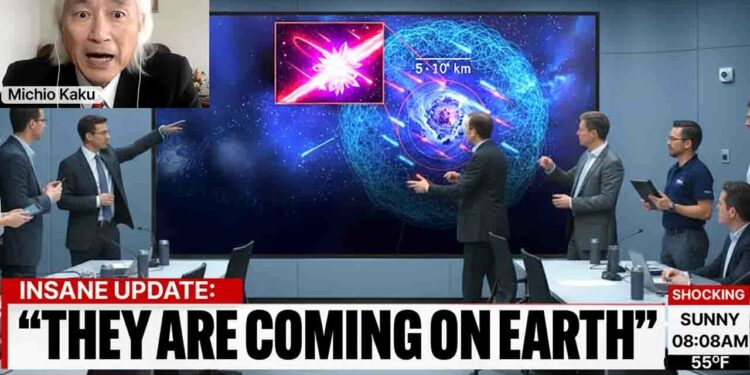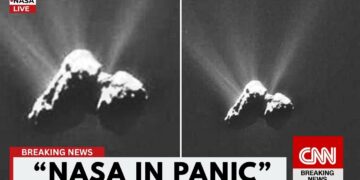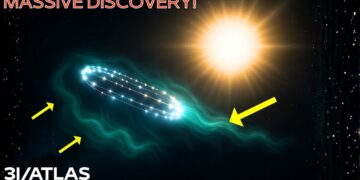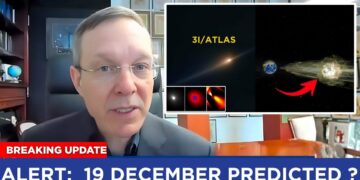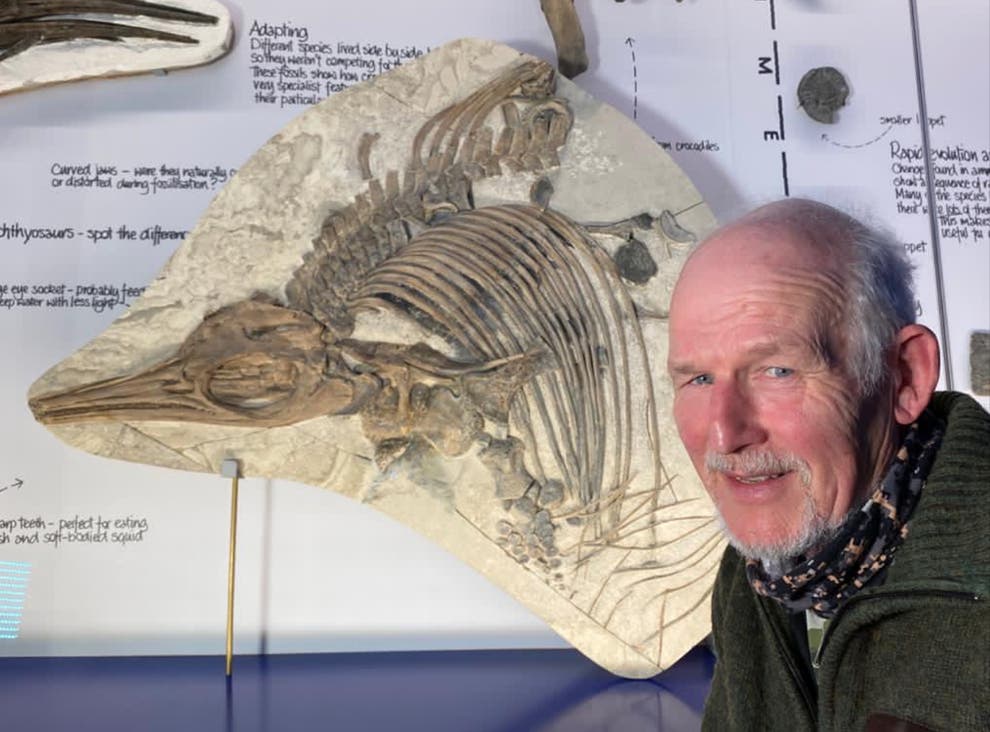When Comet 3I Atlas reaches its closest point to the Sun, Earth will be on the opposite side, making observation impossible. However, this precise moment could allow it to execute a maneuver to slow down and approach us. This raises the question: was this trajectory designed by some extraterrestrial intelligence? A profound mystery is unfolding in the depths of space, a revelation so staggering it could reshape humanity’s understanding of its place in the cosmos.
Renowned physicist Michio Kaku, a pioneer in pushing the boundaries of science, is raising alarms about an unprecedented phenomenon. We’ve been tracking Comet 3I Atlas, an interstellar marvel, but the true shock lies in its companions—not one, but a fleet of nine dark, undetectable entities trailing it on a path that brings them alarmingly close to Earth. These objects defy every known law of conventional astronomy, prompting questions about what might be guiding Atlas.
What has sparked this concern? The discovery that Comet 3I Atlas is not traveling alone. It is accompanied by nine silent, invisible objects—dark entities that are nearly impossible to detect, even with our most advanced telescopes. Imagine peering into the darkest corners of space and sensing something massive yet completely unseen. This is the challenge astronomers face. These nine companions, moving in perfect formation with Atlas, each radiate an astonishing 20 gigawatts of power—enough to supply countless homes—yet remain entirely hidden.
Data from the James Webb and Hubble Space Telescopes paints a breathtaking and unsettling picture. Spectroscopic analysis reveals unusual elements within these glowing anomalies: nickel, cobalt, and unknown alloys not found in natural comets. This is no ordinary space rock—it’s something entirely different. While some dismiss these findings as mere fragments, Harvard’s Avi Loeb, known for bold cosmic theories, suggests they are not fragments at all but probes shed by a mothership.
Comet 3I Atlas itself is a marvel, speeding through our solar system at approximately 38 meters per second, or 136,800 miles per hour—one of the fastest objects ever recorded in our celestial neighborhood. Yet, the presence of nine hidden, power-emitting objects moving with such precision suggests something beyond random celestial mechanics. This appears to be a meticulously orchestrated event, fueling unsettling theories.
The idea of alien life captivates many, and this discovery taps into deep human curiosity. The fact that these objects are dark, absorbing light rather than reflecting it, adds to their mystery. Are they cloaked? Are they made of materials that absorb all electromagnetic radiation? Such technology would be extraordinary. Comet 3I Atlas spans several miles, but the size and composition of its nine companions remain unknown, masked by their inexplicable darkness. Their 20-gigawatt energy signatures, however, indicate an active, purposeful presence.
The scientific community, typically cautious, finds itself in uncharted territory. Comet 3I Atlas will pass within 135 million miles of the Sun, just inside Mars’ orbit. While NASA assures us it poses no direct threat to Earth, the nature of its companions fuels Dr. Kaku’s concerns. What could travel so far, remain so hidden, and emit such power? We stand on the brink of a new understanding, one that could challenge our very foundations. What else might be hiding in plain sight—or rather, in plain darkness?
The question of why these objects are invisible to our most powerful telescopes is where the science becomes truly intriguing. Telescopes like Hubble and James Webb rely on detecting light, either emitted or reflected. These dark objects do neither in a way our instruments can easily capture. What if they are coated in a material that absorbs 99.9% of electromagnetic radiation, rendering them nearly invisible against the black backdrop of space? Even a slight change in reflectivity can make an object vanish. The presence of nickel, cobalt, and unknown alloys suggests an engineered origin, unlike the ice, dust, and rock of typical comets.
The 20-gigawatt energy output per object, sustained across interstellar distances, implies a power source far beyond our technology. A modern nuclear power plant generates 1 to 3 gigawatts, yet these objects produce 10 to 20 times that without a visible signature. Their gravitational pull, while present, may be too subtle to detect from millions of miles away, especially if they are relatively small. However, their precise movement with Atlas suggests a controlled, non-natural propulsion system, pushing us into the realm of advanced engineering.
This phenomenon echoes science fiction themes of stealth technology, but seeing it in real data is another matter entirely. Studying something invisible challenges our instruments and theoretical frameworks. These nine dark objects urge us to look beyond our current knowledge, raising questions about the limits of our understanding of the universe.
The arrival of Comet 3I Atlas builds on a history of puzzling interstellar visitors. The first, ‘Oumuamua, discovered in 2017, baffled scientists with its cigar-like shape and unexpected acceleration. Harvard’s Avi Loeb suggested it could be an alien probe. Then came 2I/Borisov in 2019, a more conventional comet but still a fascinating visitor. These objects show our solar system is a cosmic crossroads, yet only recent advances in sky surveys have made their detection possible. Countless others may have passed unnoticed over billions of years.
If ‘Oumuamua hinted at a solitary probe, Comet 3I Atlas and its fleet suggest something far more complex—a potential armada. The distances involved are staggering; traveling from another star system takes thousands or millions of years. Any engineered objects would require materials and power sources capable of enduring the harsh conditions of space. Their longevity and stealth would point to a civilization far more advanced than ours.
Our galaxy contains 100 to 400 billion stars, making it statistically likely that intelligent life exists elsewhere. To such civilizations, our technology might seem primitive, their methods indistinguishable from natural phenomena. As Dr. Kaku notes, the silent passage of these objects reminds us how much we don’t know. We may be searching for the wrong signals, expecting radio waves when they use quantum entanglement or visible light when they employ stealth technology.
The saga of Comet 3I Atlas and its nine companions brings a sense of urgency. While it poses no immediate threat, passing 170 million miles from Earth, the implications are profound. This could be a cosmic event of unparalleled significance, redefining our perspective on life beyond Earth. Interstellar objects like Atlas offer a chance to study material from distant star systems, but the addition of these dark companions raises the stakes.
Dr. Kaku’s warnings, rooted in his deep understanding of physics, push us to consider possibilities once confined to science fiction. If these objects are more than natural phenomena, we may not just be observers but subjects of observation. This raises questions about our place in the cosmos: Are we alone? How advanced are other civilizations? What are their intentions?
The challenge of detecting these objects highlights gaps in our space defense systems. If something this powerful can approach undetected, what else might be out there? The urgency stems not from panic but from a thirst for knowledge. Each observation of Comet 3I Atlas and its companions is a clue in a cosmic detective story, offering a glimpse into the universe’s vast possibilities.
As Comet 3I Atlas continues its journey, humanity stands at a crossroads. The alarms raised by figures like Dr. Kaku serve as a wake-up call, reminding us that the universe may be far stranger and more populated than we imagine. While the comet itself is a confirmed interstellar object, the nine dark objects and mothership theories remain speculative, driven by unusual data. This distinction—between confirmed data and exciting hypotheses—fuels both scientific inquiry and public imagination.
Are we prepared for what these objects might reveal? If this cosmic mystery intrigues you, stay tuned for more mind-bending revelations.

